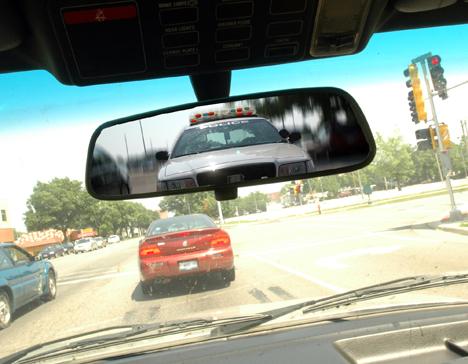Survey says: More minorities stopped

Beck Diefenbach The Daily Illini Beck Diefenbach
July 18, 2006
According to a statewide report released late last month, both Champaign and Urbana Police Departments stop a disproportionately higher amount of minority drivers other than Caucasians.
But according to Champaign Police Chief RT Finney, the numbers do not necessarily mean that officers are racially profiling.
The Illinois Racial Profiling Study, which began in 2004 and is administered by the Illinois Department of Transportation, involved approximately one thousand police agencies across the state. The study collects data on the ratio of the estimated minority driving population compared to the percentage of stops involving minority drivers.
The study also examines the reason for the stop as well as whether the officer conducted a consent search of the vehicle.
“The purpose of the ongoing study is to determine what the facts are,” said Mike Claffey, spokesman for the Illinois Department of Transportation. “Also, to determine where the individual communities stand compared to the state and to their neighbors,”
Get The Daily Illini in your inbox!
According to the study, minority drivers represent about 40 percent of all traffic stops in Champaign while representing only 25 percent of drivers.
But the Champaign Police Department challenges the “benchmark” data, which refers to the estimated minority driving population.
“We still believe that the use of the 2000 Census Data is a weak and inaccurate means of arriving at a benchmark for motorist demographics in the city of Champaign,” said comments added to the report by the Champaign Police Department.
“The problem is that we can show that the Census is not a good benchmark, and we can offer up other areas that may be benchmarks,” Finney said. “But we don’t know that those are good benchmarks anyway.”
Utilizing the last two years demographic data from motorist involved in accidents and stopped for radar based speeding violations, the Champaign Police Department claim that minority drivers represent about 28 percent of drivers, not the 25 percent suggested by the report.
According to Finney, the Champaign Police Department places its largest amount of resources, including the number of police officers, into areas of economic underdevelopment. As a result, there are more traffic stops in areas that have a larger minority population.
“If you think you have been unfairly stopped then you should contact us and we can look into the issue,” Finney said.
In Urbana, minority drivers represented 44 percent of all traffic stops, but only 31 percent of drivers.
Multiple calls to the Urbana Police Department were not returned.
“The large benefit of these numbers is for the local police departments,” said State Senator Kwame Raoul (D-Chicago). Raoul co-chairs the state’s Racial Profiling Task Force, which Governor Rod Blagojevich called for in the wake of the 2004 report.
According to Blagojevich, this advisory board is in charge of coordinating the development and adoption of plans and strategies to eliminate racial profiling in Illinois. It is also responsible for developing policies for police agencies designed to protect the civil rights of individuals’ involved in traffic stops.
When informed of Champaign and Urbana’s report data, Raoul said that the numbers may not tell the whole story.
“I think what the department is doing as a whole is not necessarily reflected in the end number,” he said. “Maybe a particular officer has a problem or a particular part of Champaign is racially profiled.”
According to Raoul, those are important factors that need be examined before determining whether there is a discriminatory explanation to the study’s numbers.
The report shows that both Champaign and Urbana Police Departments issued citations nearly equally between minority and Caucasian drivers. In Champaign, Caucasian drivers are issued citations in about 57 percent of all stops while minority drivers are issued citations about 59 percent of the time.
Urbana Police issued citations to Caucasian drivers in about 63 percent of traffic stops, as compared to about 65 percent for minority drivers.
Statewide results for the first two years of the study showed that minorities were more likely that whites to be pulled over for a traffic stop and also more likely to be subjected to a consent search.
For 2005, the overall number of stops was about the same, and there was a slight dip in the total number of minorities stopped.
“The profiling study has already had a positive effect on law enforcement by helping to reduce the number of drivers that are stopped or cited without a valid reason,” said State Representative Monique Davis (D-Chicago).
But some government officials are not as convinced that this year’s numbers represent any real changes.
“I don’t know how significant that is,” said Raoul, referring to the drop in statewide minority stops. “We don’t know what it all means just yet.”
After the report’s release, Blagojevich signed legislation to extend the study. Scheduled to end December 31, 2007, Senate Bill 2368 extends the study through July 1, 2010.
“Three years simply is not enough time for a study as important as this,” Blagojevich said in a press release. “We want to take every step possible to ensure that everyone is treated fairly and equally during traffic stops.”
The bill also increases the frequency in which police agencies must provide their reports from annually to twice a year.
Data for Illinois’ Racial Profiling study is collected by the Illinois Department of Transportation in partnership with the Northwestern University Center for Public Safety, which provides analysis of the data.
According to Raoul, the additions of categories to the study – including duration of the traffic stop, whether or not a consent search was requested and whether contraband was found during the search – will help analysts better understand what the data reveals.
“Extending the study ensures that we do not jump to conclusions prematurely,” he said.






